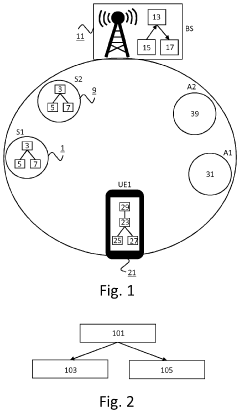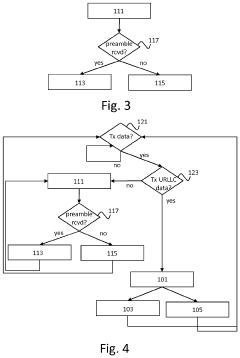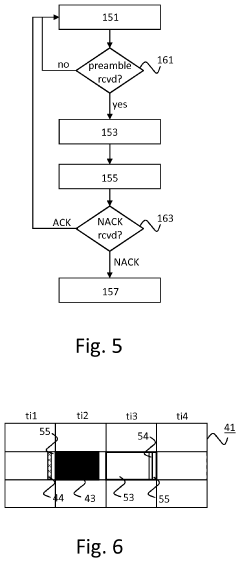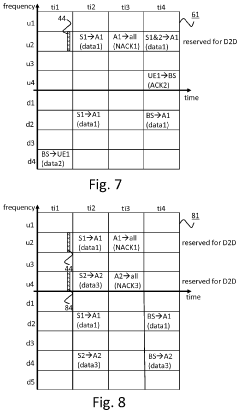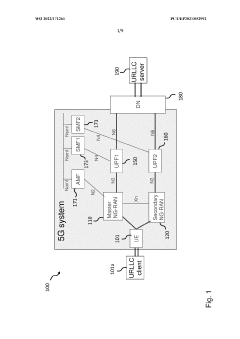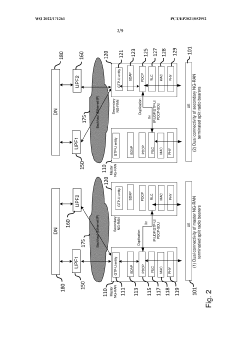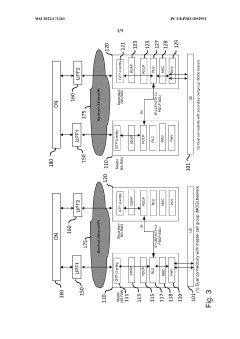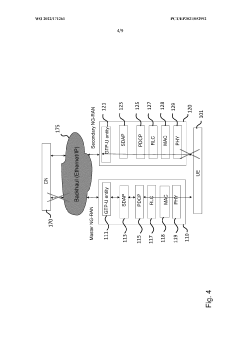What are the Challenges of 5G UC in High-Speed Train Communication?
JUL 18, 20259 MIN READ
Generate Your Research Report Instantly with AI Agent
Patsnap Eureka helps you evaluate technical feasibility & market potential.
5G UC Train Comm Background and Objectives
The evolution of mobile communication technologies has led to the development of 5G, which promises unprecedented connectivity and performance. Within this context, 5G Ultra-Reliable Low-Latency Communication (URLLC) has emerged as a critical component for enabling advanced applications in various sectors, including transportation. The application of 5G URLLC in high-speed train communication represents a significant technological leap, aiming to enhance passenger experience, improve operational efficiency, and ensure safety in rail transportation.
The primary objective of implementing 5G URLLC in high-speed train communication is to overcome the limitations of existing communication systems. Current technologies struggle to maintain stable connections and deliver consistent performance in high-mobility scenarios, particularly at speeds exceeding 300 km/h. 5G URLLC aims to provide seamless connectivity, ultra-low latency, and high reliability, even in these challenging environments.
The technical goals for 5G URLLC in train communication include achieving end-to-end latencies of less than 1 millisecond, reliability rates of 99.9999%, and maintaining these performance metrics at speeds up to 500 km/h. These ambitious targets are essential for supporting critical applications such as train control systems, real-time monitoring, and passenger infotainment services.
The development of 5G URLLC for high-speed train communication is driven by several key factors. The increasing demand for high-quality, uninterrupted connectivity from passengers, the need for more efficient and safer train operations, and the push towards smart and autonomous transportation systems all contribute to the urgency of this technological advancement.
However, implementing 5G URLLC in high-speed train scenarios presents unique challenges. The rapid movement of trains causes frequent handovers between base stations, leading to potential connection instabilities. Doppler effects and fast fading phenomena further complicate signal transmission and reception. Additionally, the linear nature of railway networks requires specialized network planning and optimization to ensure consistent coverage along the entire route.
As the technology evolves, researchers and industry players are focusing on developing innovative solutions to address these challenges. These include advanced beamforming techniques, predictive handover algorithms, and the integration of artificial intelligence for network optimization. The successful implementation of 5G URLLC in high-speed train communication is expected to revolutionize rail transportation, paving the way for enhanced safety, efficiency, and passenger satisfaction in the coming years.
The primary objective of implementing 5G URLLC in high-speed train communication is to overcome the limitations of existing communication systems. Current technologies struggle to maintain stable connections and deliver consistent performance in high-mobility scenarios, particularly at speeds exceeding 300 km/h. 5G URLLC aims to provide seamless connectivity, ultra-low latency, and high reliability, even in these challenging environments.
The technical goals for 5G URLLC in train communication include achieving end-to-end latencies of less than 1 millisecond, reliability rates of 99.9999%, and maintaining these performance metrics at speeds up to 500 km/h. These ambitious targets are essential for supporting critical applications such as train control systems, real-time monitoring, and passenger infotainment services.
The development of 5G URLLC for high-speed train communication is driven by several key factors. The increasing demand for high-quality, uninterrupted connectivity from passengers, the need for more efficient and safer train operations, and the push towards smart and autonomous transportation systems all contribute to the urgency of this technological advancement.
However, implementing 5G URLLC in high-speed train scenarios presents unique challenges. The rapid movement of trains causes frequent handovers between base stations, leading to potential connection instabilities. Doppler effects and fast fading phenomena further complicate signal transmission and reception. Additionally, the linear nature of railway networks requires specialized network planning and optimization to ensure consistent coverage along the entire route.
As the technology evolves, researchers and industry players are focusing on developing innovative solutions to address these challenges. These include advanced beamforming techniques, predictive handover algorithms, and the integration of artificial intelligence for network optimization. The successful implementation of 5G URLLC in high-speed train communication is expected to revolutionize rail transportation, paving the way for enhanced safety, efficiency, and passenger satisfaction in the coming years.
Market Analysis for 5G UC in Rail Transport
The market for 5G Ultra-Reliable Low-Latency Communication (URLLC) in rail transport is experiencing significant growth and transformation. As high-speed rail networks expand globally, the demand for advanced communication technologies to support safety, efficiency, and passenger experience is increasing. The rail industry is actively seeking solutions to overcome the challenges posed by high-speed environments, making 5G UC a promising technology for this sector.
The potential market size for 5G UC in rail transport is substantial. With major economies investing heavily in rail infrastructure, the need for robust communication systems is paramount. Countries like China, Japan, and several European nations are at the forefront of high-speed rail development, driving the demand for cutting-edge communication technologies. The market is expected to grow as more countries adopt high-speed rail systems and existing networks upgrade their communication infrastructure.
Key market drivers include the need for enhanced safety measures, improved operational efficiency, and the growing expectations of passengers for seamless connectivity during their journeys. 5G UC offers the potential to revolutionize train control systems, enable real-time monitoring and predictive maintenance, and provide passengers with high-quality internet access even at high speeds.
The competitive landscape in this market is diverse, with both established telecommunications companies and specialized rail technology providers vying for market share. Major telecom equipment manufacturers are developing 5G solutions specifically tailored for the rail sector, while rail technology companies are partnering with telecom experts to integrate 5G capabilities into their existing systems.
However, the market faces several challenges. The high cost of infrastructure deployment, the need for extensive testing and certification to meet stringent safety standards, and the complexity of implementing 5G systems in existing rail networks are significant hurdles. Additionally, the varying regulatory environments across different countries can complicate the adoption and standardization of 5G UC technologies in rail transport.
Despite these challenges, the long-term outlook for 5G UC in rail transport remains positive. As technology advances and costs decrease, the adoption rate is expected to accelerate. The market is likely to see a phased approach, with initial deployments focusing on critical safety and operational applications, followed by broader implementation for passenger services and advanced analytics.
In conclusion, the market for 5G UC in rail transport presents significant opportunities for technology providers and rail operators alike. As the industry continues to evolve and address current challenges, 5G UC is poised to play a crucial role in shaping the future of high-speed rail communication systems.
The potential market size for 5G UC in rail transport is substantial. With major economies investing heavily in rail infrastructure, the need for robust communication systems is paramount. Countries like China, Japan, and several European nations are at the forefront of high-speed rail development, driving the demand for cutting-edge communication technologies. The market is expected to grow as more countries adopt high-speed rail systems and existing networks upgrade their communication infrastructure.
Key market drivers include the need for enhanced safety measures, improved operational efficiency, and the growing expectations of passengers for seamless connectivity during their journeys. 5G UC offers the potential to revolutionize train control systems, enable real-time monitoring and predictive maintenance, and provide passengers with high-quality internet access even at high speeds.
The competitive landscape in this market is diverse, with both established telecommunications companies and specialized rail technology providers vying for market share. Major telecom equipment manufacturers are developing 5G solutions specifically tailored for the rail sector, while rail technology companies are partnering with telecom experts to integrate 5G capabilities into their existing systems.
However, the market faces several challenges. The high cost of infrastructure deployment, the need for extensive testing and certification to meet stringent safety standards, and the complexity of implementing 5G systems in existing rail networks are significant hurdles. Additionally, the varying regulatory environments across different countries can complicate the adoption and standardization of 5G UC technologies in rail transport.
Despite these challenges, the long-term outlook for 5G UC in rail transport remains positive. As technology advances and costs decrease, the adoption rate is expected to accelerate. The market is likely to see a phased approach, with initial deployments focusing on critical safety and operational applications, followed by broader implementation for passenger services and advanced analytics.
In conclusion, the market for 5G UC in rail transport presents significant opportunities for technology providers and rail operators alike. As the industry continues to evolve and address current challenges, 5G UC is poised to play a crucial role in shaping the future of high-speed rail communication systems.
5G UC Train Comm Challenges and Limitations
The implementation of 5G Ultra-Reliable Low-Latency Communication (URLLC) in high-speed train environments faces several significant challenges and limitations. These obstacles stem from the unique characteristics of railway communication systems and the demanding requirements of 5G UC technology.
One of the primary challenges is the high mobility of trains, which can reach speeds of up to 350 km/h. This rapid movement causes frequent handovers between base stations, leading to potential communication interruptions and increased latency. The Doppler effect, resulting from the high-speed motion, further complicates signal processing and can cause signal distortion.
The railway environment itself presents physical obstacles that impede reliable communication. Tunnels, cuttings, and viaducts create signal shadowing and multipath fading effects, which can significantly degrade signal quality and reliability. These structures also contribute to rapid changes in channel conditions, making it difficult to maintain stable connections.
Another critical limitation is the need for ultra-low latency in train control and safety systems. 5G UC aims to provide latencies as low as 1 ms, but achieving this consistently in a high-speed, highly mobile environment is extremely challenging. The frequent handovers and changing network conditions can introduce additional delays that may compromise the ultra-low latency requirements.
The linear nature of railway networks also presents unique challenges for network planning and optimization. Base station placement and coverage must be carefully designed to ensure continuous connectivity along the entire route, including areas with sparse population or difficult terrain. This linear topology can lead to increased interference between adjacent cells and complicate frequency reuse strategies.
Power constraints on trains and trackside equipment pose another limitation. The need for energy-efficient communication systems that can operate reliably over long distances without frequent maintenance is crucial. This requirement must be balanced with the high-performance demands of 5G UC technology.
Lastly, the integration of 5G UC with existing railway communication systems, such as GSM-R, presents both technical and operational challenges. Ensuring seamless interoperability and backward compatibility while introducing new 5G capabilities requires careful planning and implementation strategies. The transition period may involve complex hybrid systems that need to maintain the highest levels of safety and reliability.
One of the primary challenges is the high mobility of trains, which can reach speeds of up to 350 km/h. This rapid movement causes frequent handovers between base stations, leading to potential communication interruptions and increased latency. The Doppler effect, resulting from the high-speed motion, further complicates signal processing and can cause signal distortion.
The railway environment itself presents physical obstacles that impede reliable communication. Tunnels, cuttings, and viaducts create signal shadowing and multipath fading effects, which can significantly degrade signal quality and reliability. These structures also contribute to rapid changes in channel conditions, making it difficult to maintain stable connections.
Another critical limitation is the need for ultra-low latency in train control and safety systems. 5G UC aims to provide latencies as low as 1 ms, but achieving this consistently in a high-speed, highly mobile environment is extremely challenging. The frequent handovers and changing network conditions can introduce additional delays that may compromise the ultra-low latency requirements.
The linear nature of railway networks also presents unique challenges for network planning and optimization. Base station placement and coverage must be carefully designed to ensure continuous connectivity along the entire route, including areas with sparse population or difficult terrain. This linear topology can lead to increased interference between adjacent cells and complicate frequency reuse strategies.
Power constraints on trains and trackside equipment pose another limitation. The need for energy-efficient communication systems that can operate reliably over long distances without frequent maintenance is crucial. This requirement must be balanced with the high-performance demands of 5G UC technology.
Lastly, the integration of 5G UC with existing railway communication systems, such as GSM-R, presents both technical and operational challenges. Ensuring seamless interoperability and backward compatibility while introducing new 5G capabilities requires careful planning and implementation strategies. The transition period may involve complex hybrid systems that need to maintain the highest levels of safety and reliability.
Current 5G UC Train Comm Solutions
01 Network architecture and resource allocation
Challenges in designing network architectures and allocating resources efficiently to meet URLLC requirements. This includes optimizing network slicing, dynamic resource allocation, and balancing between reliability and latency demands.- Network architecture and resource allocation: 5G UC faces challenges in designing efficient network architectures and allocating resources to meet ultra-reliable and low-latency requirements. This involves optimizing radio access networks, core networks, and edge computing resources to minimize latency and ensure high reliability for critical applications.
- Interference management and channel estimation: Managing interference and accurately estimating channel conditions are crucial challenges for 5G UC. Advanced techniques for interference cancellation, mitigation, and coordination are needed to maintain reliable communication in dense networks. Precise channel estimation is essential for adapting transmission parameters and ensuring low latency.
- Mobility management and handover optimization: Ensuring seamless mobility and optimizing handover procedures are significant challenges for 5G UC. Maintaining ultra-reliable and low-latency communication during user movement and cell transitions requires advanced mobility management techniques and fast handover mechanisms.
- Security and privacy in low-latency communications: Implementing robust security measures while maintaining low latency is a critical challenge for 5G UC. Developing lightweight encryption algorithms, fast authentication methods, and secure protocols that do not introduce significant delays is essential for protecting sensitive data in ultra-reliable communications.
- Energy efficiency and power management: Balancing energy efficiency with the high performance requirements of 5G UC is a significant challenge. Developing power-efficient hardware, optimizing network operations, and implementing intelligent power management techniques are crucial for sustainable ultra-reliable and low-latency communications.
02 Interference management and mitigation
Addressing interference issues in dense 5G networks to ensure ultra-reliable communication. This involves developing advanced interference cancellation techniques, coordinated multipoint transmission, and adaptive beamforming strategies.Expand Specific Solutions03 Channel estimation and prediction
Improving channel estimation and prediction accuracy for URLLC scenarios. This includes developing algorithms for fast and precise channel state information acquisition, and predictive modeling to anticipate channel variations.Expand Specific Solutions04 Mobility management and handover optimization
Enhancing mobility management and handover procedures to maintain ultra-reliable connections for moving users or devices. This involves developing seamless handover techniques, predictive handover algorithms, and multi-connectivity solutions.Expand Specific Solutions05 End-to-end latency reduction
Minimizing end-to-end latency in URLLC applications. This includes optimizing packet scheduling, reducing processing delays, implementing edge computing solutions, and developing low-latency coding and modulation schemes.Expand Specific Solutions
Key Players in 5G UC Rail Solutions
The 5G UC (Ultra-Capacity) technology for high-speed train communication is in its early development stage, with significant market potential but facing several technical challenges. The market is expected to grow rapidly as countries invest in high-speed rail infrastructure and demand for seamless connectivity increases. Key players like Qualcomm, Ericsson, ZTE, and Samsung are actively developing solutions, focusing on overcoming issues such as frequent handovers, Doppler effect, and maintaining reliable connections at high speeds. While the technology is progressing, it is not yet fully mature, with ongoing research and trials being conducted by universities and telecom companies to address the unique challenges posed by the high-speed rail environment.
ZTE Corp.
Technical Solution: ZTE has developed a comprehensive 5G UC solution tailored for high-speed railway communications. Their approach includes the deployment of a specialized Radio Access Network (RAN) that utilizes advanced beamforming and tracking techniques to maintain stable connections with trains moving at high speeds[13]. ZTE's system incorporates a distributed unit (DU) architecture that allows for flexible network deployment along railway lines, optimizing coverage and capacity[14]. They have also implemented an AI-driven network optimization engine that continuously adjusts parameters based on train location, speed, and network load[15]. Furthermore, ZTE's solution includes a dedicated core network slice for railway operations, ensuring prioritized and secure communication for critical train control systems[16].
Strengths: Strong presence in the Chinese market, extensive experience with large-scale network deployments. Weaknesses: International expansion may face regulatory challenges, potential concerns over technology security in some markets.
QUALCOMM, Inc.
Technical Solution: Qualcomm has focused on developing chipset solutions specifically designed for 5G UC in high-speed train scenarios. Their latest modem-RF system incorporates advanced signal processing techniques to mitigate the effects of high-speed movement on signal quality[9]. Qualcomm's solution includes a proprietary algorithm for rapid channel estimation and tracking, enabling devices to maintain stable connections even under extreme Doppler shifts[10]. They have also implemented a multi-antenna diversity scheme that enhances signal reception in challenging environments such as tunnels and mountainous terrain[11]. Additionally, Qualcomm's chipsets support seamless integration with various network architectures, including distributed antenna systems commonly used in railway corridors[12].
Strengths: Industry-leading chipset technology, strong partnerships with device manufacturers. Weaknesses: Dependent on network infrastructure providers for full solution implementation, potential licensing cost concerns for some markets.
Core Innovations in 5G UC for Trains
Reliable low latency communication over shared resources
PatentActiveUS11792840B2
Innovation
- The solution involves using device-to-device (D2D) communication by transmitting data in multiple separate frequency resources, with a preamble indicating urgent data transmission, allowing other devices to refrain from transmitting during this time, thereby maintaining reliability without increasing latency.
Devices, systems and methods for urllc in a 5g communication network
PatentWO2022171261A1
Innovation
- The implementation of redundant data paths using a network entity that establishes dual PDU sessions with primary and secondary next-generation radio access networks (NG-RANs), employing packet duplication and elimination entities to ensure data reliability and availability by duplicating and eliminating Ethernet frames or DetNet-IP packets across independent paths.
Regulatory Framework for 5G UC in Rail
The regulatory framework for 5G Ultra-Reliable Low-Latency Communication (URLLC) in rail environments is a critical aspect of implementing advanced communication technologies in high-speed train systems. This framework must address the unique challenges posed by the railway sector while ensuring the safe and efficient operation of 5G networks.
One of the primary considerations in developing this regulatory framework is the allocation of spectrum for railway-specific 5G applications. Regulatory bodies must work closely with railway operators and telecommunications providers to identify and allocate appropriate frequency bands that can support the high-speed, low-latency requirements of train communications without interfering with other critical systems.
Safety and reliability standards form another crucial component of the regulatory framework. Given the potential risks associated with high-speed rail travel, regulators must establish stringent guidelines for the deployment and operation of 5G URLLC systems. These standards should cover aspects such as network redundancy, failover mechanisms, and cybersecurity measures to ensure uninterrupted and secure communications.
Interoperability is a key concern that the regulatory framework must address. As trains often cross national borders, there is a need for harmonized standards and regulations across different jurisdictions. This includes aligning technical specifications, operational procedures, and compliance requirements to enable seamless 5G connectivity throughout international rail networks.
The framework should also incorporate provisions for testing and certification of 5G URLLC equipment and systems specifically designed for railway applications. This may involve establishing specialized testing facilities and procedures to verify the performance and reliability of these systems under the unique conditions encountered in rail environments.
Environmental and health considerations must be factored into the regulatory framework as well. This includes setting guidelines for electromagnetic emissions from 5G equipment installed along railway tracks and on trains, ensuring compliance with international standards for human exposure to electromagnetic fields.
Additionally, the regulatory framework should address data privacy and protection issues related to the use of 5G URLLC in rail communications. This involves establishing clear guidelines on the collection, storage, and use of passenger and operational data, as well as defining responsibilities and liabilities in the event of data breaches or system failures.
Lastly, the framework should include provisions for ongoing monitoring and evaluation of 5G URLLC deployments in rail environments. This will allow regulators to assess the effectiveness of the implemented regulations, identify areas for improvement, and adapt the framework as technology and operational requirements evolve.
One of the primary considerations in developing this regulatory framework is the allocation of spectrum for railway-specific 5G applications. Regulatory bodies must work closely with railway operators and telecommunications providers to identify and allocate appropriate frequency bands that can support the high-speed, low-latency requirements of train communications without interfering with other critical systems.
Safety and reliability standards form another crucial component of the regulatory framework. Given the potential risks associated with high-speed rail travel, regulators must establish stringent guidelines for the deployment and operation of 5G URLLC systems. These standards should cover aspects such as network redundancy, failover mechanisms, and cybersecurity measures to ensure uninterrupted and secure communications.
Interoperability is a key concern that the regulatory framework must address. As trains often cross national borders, there is a need for harmonized standards and regulations across different jurisdictions. This includes aligning technical specifications, operational procedures, and compliance requirements to enable seamless 5G connectivity throughout international rail networks.
The framework should also incorporate provisions for testing and certification of 5G URLLC equipment and systems specifically designed for railway applications. This may involve establishing specialized testing facilities and procedures to verify the performance and reliability of these systems under the unique conditions encountered in rail environments.
Environmental and health considerations must be factored into the regulatory framework as well. This includes setting guidelines for electromagnetic emissions from 5G equipment installed along railway tracks and on trains, ensuring compliance with international standards for human exposure to electromagnetic fields.
Additionally, the regulatory framework should address data privacy and protection issues related to the use of 5G URLLC in rail communications. This involves establishing clear guidelines on the collection, storage, and use of passenger and operational data, as well as defining responsibilities and liabilities in the event of data breaches or system failures.
Lastly, the framework should include provisions for ongoing monitoring and evaluation of 5G URLLC deployments in rail environments. This will allow regulators to assess the effectiveness of the implemented regulations, identify areas for improvement, and adapt the framework as technology and operational requirements evolve.
Safety and Reliability Considerations
Safety and reliability are paramount concerns in the implementation of 5G UC (Ultra-Reliable Low-Latency Communication) for high-speed train communication systems. The dynamic and challenging environment of high-speed rail presents unique obstacles that must be addressed to ensure passenger safety and maintain reliable connectivity.
One of the primary safety considerations is the need for seamless handovers between base stations as trains move at high velocities. The frequent handovers required in high-speed scenarios can potentially lead to communication interruptions, which may impact critical safety systems and passenger information services. Ensuring smooth transitions between cells without compromising the ultra-low latency and high reliability promised by 5G UC is a significant challenge that requires advanced network optimization techniques.
The reliability of 5G UC in high-speed train environments is also affected by the Doppler effect, which causes frequency shifts in the transmitted signals due to the relative motion between the train and base stations. This phenomenon can lead to signal distortion and degradation, potentially compromising the quality and stability of communication links. Developing robust signal processing algorithms and adaptive modulation schemes to mitigate these effects is crucial for maintaining reliable connectivity.
Another critical safety aspect is the integration of 5G UC with existing train control and signaling systems. The migration from legacy systems to 5G-based solutions must be carefully managed to ensure continuous operation and prevent any safety-critical failures during the transition period. This requires extensive testing and validation procedures to verify the interoperability and performance of 5G UC in conjunction with existing railway infrastructure.
Cybersecurity is an increasingly important consideration in the context of 5G UC for high-speed trains. As more systems become interconnected and reliant on wireless communication, the potential attack surface for malicious actors expands. Implementing robust encryption, authentication mechanisms, and intrusion detection systems is essential to protect against cyber threats that could compromise safety-critical functions or passenger data.
Environmental factors such as tunnels, viaducts, and adverse weather conditions pose additional challenges to the reliability of 5G UC in railway scenarios. These obstacles can cause signal attenuation, multipath fading, and temporary loss of line-of-sight, potentially disrupting communication links. Developing resilient network architectures and employing advanced antenna technologies, such as massive MIMO and beamforming, can help overcome these environmental challenges and maintain consistent connectivity.
Lastly, the redundancy and fault tolerance of 5G UC systems must be carefully designed to ensure continuous operation in the event of hardware failures or network disruptions. Implementing backup communication channels, distributed network architectures, and intelligent failover mechanisms is crucial for maintaining the ultra-high reliability required for safety-critical applications in high-speed train environments.
One of the primary safety considerations is the need for seamless handovers between base stations as trains move at high velocities. The frequent handovers required in high-speed scenarios can potentially lead to communication interruptions, which may impact critical safety systems and passenger information services. Ensuring smooth transitions between cells without compromising the ultra-low latency and high reliability promised by 5G UC is a significant challenge that requires advanced network optimization techniques.
The reliability of 5G UC in high-speed train environments is also affected by the Doppler effect, which causes frequency shifts in the transmitted signals due to the relative motion between the train and base stations. This phenomenon can lead to signal distortion and degradation, potentially compromising the quality and stability of communication links. Developing robust signal processing algorithms and adaptive modulation schemes to mitigate these effects is crucial for maintaining reliable connectivity.
Another critical safety aspect is the integration of 5G UC with existing train control and signaling systems. The migration from legacy systems to 5G-based solutions must be carefully managed to ensure continuous operation and prevent any safety-critical failures during the transition period. This requires extensive testing and validation procedures to verify the interoperability and performance of 5G UC in conjunction with existing railway infrastructure.
Cybersecurity is an increasingly important consideration in the context of 5G UC for high-speed trains. As more systems become interconnected and reliant on wireless communication, the potential attack surface for malicious actors expands. Implementing robust encryption, authentication mechanisms, and intrusion detection systems is essential to protect against cyber threats that could compromise safety-critical functions or passenger data.
Environmental factors such as tunnels, viaducts, and adverse weather conditions pose additional challenges to the reliability of 5G UC in railway scenarios. These obstacles can cause signal attenuation, multipath fading, and temporary loss of line-of-sight, potentially disrupting communication links. Developing resilient network architectures and employing advanced antenna technologies, such as massive MIMO and beamforming, can help overcome these environmental challenges and maintain consistent connectivity.
Lastly, the redundancy and fault tolerance of 5G UC systems must be carefully designed to ensure continuous operation in the event of hardware failures or network disruptions. Implementing backup communication channels, distributed network architectures, and intelligent failover mechanisms is crucial for maintaining the ultra-high reliability required for safety-critical applications in high-speed train environments.
Unlock deeper insights with Patsnap Eureka Quick Research — get a full tech report to explore trends and direct your research. Try now!
Generate Your Research Report Instantly with AI Agent
Supercharge your innovation with Patsnap Eureka AI Agent Platform!
